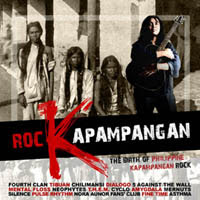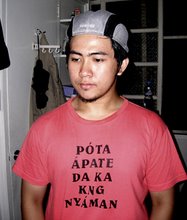By Robby Tantingco
Peanut Gallery
OUR language today is in such an advanced state of deterioration that even if the National Statistics Office says that about 88 percent of the population in Pampanga speak Kapampangan, it's the kind of Kapampangan that's spoken in the streets -- very colloquial, very limited vocabulary, and borrowing heavily from Tagalog and English.
Only 100 years ago, we were producing the country's longest play and first vernacular zarzuela, and there were more poets and writers per square meter here than in any other region in the Philippines , wrote former Manila Times editor Jose Luna Castro.
Today, most of those who still speak Kapampangan can neither read nor write in Kapampangan, which means we have become illiterates in our own language. It also means that if Kapampangan exists only in spoken form and not in written, then it's good for only one or two more generations, and then it's gone.
From its golden age to its death throes in less than one hundred years -- what happened?
Well, first, the government created a national language, which became the medium of media, including TV and cinema, which wiped out the traditional forms of public entertainment like zarzuela, crissotan and kuriru, which were the last refuge of classical Kapampangan.
Second, Kapampangan was taken out of schools, which led students to think it is inferior to Tagalog and English, which discouraged them from using it in intellectual discussions, which prevented it from evolving and expanding its vocabulary.
Today, many individuals and institutions are working to save the language, but they are independent of each other, uncoordinated, always arguing and debating.
Since the new Governor enjoys unprecedented popularity and credibility, he can probably summon all these fractious parties to a language summit, but on second thought, maybe a summit is not a good idea, because some may only use it to grandstand or push their own agenda, and it might divide rather than unite.
I suggest that the Provincial Government first pass a resolution requiring all public elementary and high schools in Pampanga to include Kapampangan in the curriculum. The resolution should include mandatory teacher training and workshops on making a syllabus and constructing instructional materials. The City of San Fernando did this two years ago, and it worked. The Center for Kapampangan Studies sponsored the training-workshop.
Next, the Provincial Government should implement laws that have already been passed and only need implementation. One of them is DILG Memo Circular 2002-81 mandating all cities and municipalities to form (and fund) arts and culture councils. Each town in Pampanga will therefore have a body that promotes Kapampangan in the grassroots or barangay level, instead of relying on private institutions and advocacy organizations that have limited manpower and financial resources.
Seventeen towns in Pampanga have already passed ordinances creating their respective arts and culture councils; I know because the Center conducted a museum workshop for them about two years ago. Unfortunately, officers of those councils were co-terminus with their mayors, so the Provincial Government must remind the newly elected mayors to reactivate them.
The Provincial Government must also enforce two resolutions that are already in existence: one, asking all FM and AM radio stations in Pampanga to play Kapampangan songs morning, afternoon and evening everyday, and the other, asking all schools, malls and cinemas to do the same. Only one radio station (RW-FM) still faithfully does this; the others must be reminded.
Meanwhile, advocacy groups like the Center and the Akademyang Kapampangan and writers' associations like AGTAKA should continue producing in earnest Kapampangan materials -- literary publications, dictionaries and grammar books, and music records -- so that when the demand increases, there is enough supply to meet it.
I have a feeling that the reason radio stations have slowed down on Kapampangan songs is that the same Kapampangan songs are played over and over. ArtiSta. Rita, Mon David and the others must record more Kapampangan songs, but government and the private sector must give financial assistance. There's a group that's conducting a Kapampangan pop song festival, and Holy Angel University and Kalalangan Kamaru are planning a Kapampangan CD featuring local bands -- these are steps in the right direction.
We all must ride the momentum created by the cultural renaissance that has been sweeping the province for some time now, and use the energy to make one big push to save the language. I think our people are ready to relearn Kapampangan.
My staff at the Center have been going around public schools in Pampanga with a roving Kapampangan exhibit, giving workshops and lectures, conducting Kapampangan singing contests, and donating Kapampangan books and CDs. Based on the enthusiastic response of everyone, from pupils to teachers to principals, I can say that our people are just waiting to be taught.
The question is, are we ready to teach them? END ARTICLE
Sisigman's answer: before we'll be able to teach the new generation Kapampangan, we must first have our goal recognized legally, i.e., there should be laws or ordinances passed requiring the teaching and/or use of the Kapampangan language.
Before that happens, we need to generate people power: make Kapampangans believe in our cause and how loving your own would yield to wonderful results in the future, not only culturally, but also economically.
But before we convince people to join our cause and before they understand the bigger picture involved in policies, politics, language, heritage, etc. through education and other campaigning strategies, people should secure their basic physiological needs first: food, shelter, and clothing.
And before the physiological needs be satisfied, someone -- the government for instance -- needs to improve the balen and making it progressive, which I think is materializing right now.
We are on the right path.














